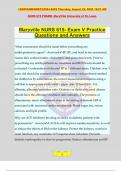©SOPHIABENNET@2024-2025 Thursday, August 22, 2024 10:21 AM
NURS 615 PHARM- MaryVille University of St. Louis
Maryville NURS 615- Exam V Practice
Questions and Answers
What assessments should be made before prescribing any
antihypertensive agent? - Answer✔️✔️-BP, RF, and head to toe assessment.
Assess diet, sodium intake, electrolytes, and potassium levels. Prior to
prescribing any antihypertensives, creatinine and BUN levels should be
evaluated. Confirmation of elevated BP at 3 different times. Children over 3
years old should be assessed at least once at every visit-preferred method
for children is by auscultation, the correct measurement requires using a
cuff that is appropriate to the child's upper arm. 12 lead EKG. UA,
albumin, albumin/creatinine ratio. Diabetics or those with renal disease
should have the albumin/creatinine ratio annually. The presence of
albuminuria, micro albuminuria even in the setting of normal GFR is
associated with increased cardiovascular risk. Blood sugar, hct, serum
calcium, and lipid profile.
Why are ACE inhibitors the drug of choice in diabetic patients with
hypertension? - Answer✔️✔️-ACE-Is will improve insulin sensitivity, as well
as reduce the effects of DM on the kidneys. Protect the kidneys, watch for
renal function, any creatinine >2.5 requires dose reduction. Prevents
diabetic nephropathy or slow its progression. Reduce albuminuria and BP.
1
, ©SOPHIABENNET@2024-2025 Thursday, August 22, 2024 10:21 AM
NURS 615 PHARM- MaryVille University of St. Louis
ACEIs and ARBs should be used to treat the HTN. Renal protection,
reduces the conversion of AT II and improve the insulin sensitivity.
What is the drug of choice to improve symptoms for patients taking
propranolol? - Answer✔️✔️-Ipratropium
What is the most common adverse effect of an ACE inhibitor? -
Answer✔️✔️-Dry, hacking cough in some patients. Can switch to an
angiotensin blocker which won't cause cough. Reduce dose with either of
these if Cr >2.5. Most are associated with hypotension, dizziness, HA,
fatigue, orthostatic hypotension, tachyphylaxis.
What is the action of an ACE inhibitor? - Answer✔️✔️-Decreases angiotensin
II and aldosterone. Vasodilatation on the venous and arterial sides of the
heart. Blocks the RAAS system leads to rennin acts on angiotensinogen to
angiotensin I to angiotensin II through ACE. Angiotensin II stimulates
aldosterone causing sodium and water while losing potassium via the
kidney. ACE is also involved in the inactivation of bradykinin a
vasodilator. Bradykin is what causes the cough (irritating the lungs).
What is the action of an Angiotensin Receptor Blocker? - Answer✔️✔️-
Blocks the angiotensin II receptor to leading to increasing vascular tone
and stimulating vascular smooth muscle contraction. One of the greatest
advantages: doesn't produce the dry, hacking cough that ACE-Is do.
Similar to ACE-I except to bradykinin activity (no cough), lowers BP,
2
, ©SOPHIABENNET@2024-2025 Thursday, August 22, 2024 10:21 AM
NURS 615 PHARM- MaryVille University of St. Louis
decreases vascular resistance, decreases pulmonary cap wedge pressure,
decreases HR, increases cardiac index.
What ethnic background should not be prescribed long-acting beta-
agonists? - Answer✔️✔️-African Americans, increased incidence of death in
this population
What is tiotropium used to treat? - Answer✔️✔️-COPD, after patient stops
smoking, this medication slow the progression of COPD.
What is the action of a Calcium Channel Blocker? - Answer✔️✔️-Decrease
the amount of calcium inside the cell to control blood pressure.
Dihydropyridine CCB: inhibits transmembrane influx of extracellular
calcium ions across myocardial and vascular smooth muscle cell
membranes without changing serum calcium concentrations. This results
in inhibition of cardiac and vascular smooth muscle contraction, thereby
dilating main coronary and systemic arteries. Vasodilatation with
decreased peripheral resistance and increased heart rate.
Nondihydropyridine CCB: inhibits extracellular calcium ion influx across
membranes of myocardial cells and vascular smooth muscle cells.
Resulting in inhibition of cardiac and vascular smooth muscle contraction
and thereby dilating main coronary and systemic arteries. No effect on
serum calcium contractions. Substantial inhibitory effects on cardiac
3
, ©SOPHIABENNET@2024-2025 Thursday, August 22, 2024 10:21 AM
NURS 615 PHARM- MaryVille University of St. Louis
conduction system, acting principally at AV node, with some effects at
sinus node.
What are the adverse effects of a dihydropyridine-type calcium channel
blocker? - Answer✔️✔️-Causes edema of the feet and hands, especially feet.
Amlodipine and nifedipine. Type 2 (dihydropyridine=vessel loving) =
peripheral edema. Type 1 (non-dihydropyridine=heart
loving)=bradycardia, dizziness, hypotension.
A 70-year-old patient is admitted with peripheral edema. He is taking a
calcium channel blocker and metformin. What is the cause of his peripheral
edema? - Answer✔️✔️-The edema is not related to metformin. Type 1 CCB
more commonly exhibit peripheral edema. Pts report swelling of the
hands, feet, ankles, and decreased urine output.
What special populations should not be prescribed pseudoephedrine? -
Answer✔️✔️-Children under the age of 4, first line treatment for coughs and
colds is increased fluids and symptomatic management. Schedule III-
addictive personalities, HTN, CAD. Children under 4= Infants cause
sudden death, not recommended for children under 4. Anytime thinking of
cough and cold medications you should always think of the elderly, very
young and HTN.
How is amlodipine metabolized? - Answer✔️✔️-All CCBs are metabolized
by the liver in the CYP 3A4. Avoid, don't administer CCB with grapefruit
4




